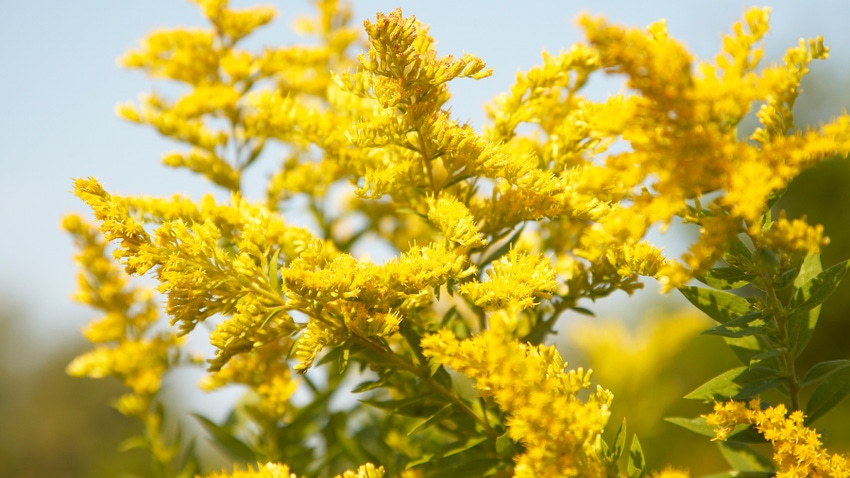July 6, 2023

by Justin Evertson
Goldenrod is our Nebraska state flower, but why isn’t it more widely planted in our rural landscapes? There’s a good reason goldenrod is Nebraska’s state flower. It’s beautiful, tough and long-lived, and it grows well across the state. However, despite its beauty, goldenrod is often wrongly vilified for causing fall allergies.
Simply put, goldenrod is not to blame for the runny noses and itchy eyes so many of us deal with as summer turns to fall. The primary source of fall allergies is ragweed, and the goldenrod is only guilty by association as it happens to bloom at the same time and in the same places as ragweed.
A good general rule to keep in mind is that most plants with showy blooms do not cause allergies, as their pollen is heavy and sticky and has evolved to be spread by insects and other pollinators.
The various ragweed species, on the other hand, have inconspicuous flowers designed to release their pollen to the wind, and some of that pollen invariably finds our noses. So, when we start sneezing and wheezing in the fall, let’s give goldenrod a break and remember that ragweed is the real troublemaker here.
Bright and showy
The benefits of goldenrod are many, starting with the bright yellow blossoms that liven up the late summer landscape and that can bloom well into fall. And even after cold weather has stopped the blooming, their fluffy seed heads add visual appeal to the winter landscape.
Goldenrod is also an excellent pollinator plant for butterflies, bees, soldier beetles, beneficial spiders and other insects, which in turn are important foods for songbirds.
For Native Americans, goldenrod blooms were a sign that corn was ready for harvesting. They also used it to make a tea to treat heart conditions, a painkiller for bee stings, and an ointment for muscle pains and toothaches.
So, let’s celebrate goldenrod and make room for it in our landscapes. But with several native species and cultivars to choose from, which ones should we plant?
A few favorites
What follows are a few of my favorites. Some are worthy of garden planting, but others are aggressive spreaders or get tall and leggy and are better to appreciate in the wild:
Showy Goldenrod (Solidago speciosa). This is a prairie native with bottlebrush spikes of showy blooms and attractive red stems. It’s a fantastic garden plant growing to 3 feet high.
Stiff Goldenrod (Solidago rigida). This is a common native known for its flat-topped flowers. It reseeds itself readily in open ground, is tough as nails and grows 3 to 4 feet tall.
Zigzag Goldenrod (Solidago flexicaulis). This is a good choice for shade or part-shade. It’s named for the way the flowers zig and zag their way up the 2– to 4-foot stems.
Wichita Mountains’ Goldenrod. This is a cultivar from Oklahoma known for its rods of bright yellow flowers on 2- to 3-foot stems. It does especially well in western Nebraska.
“Fireworks" Goldenrod (Solidago rugosa). This is well-named for the intense spray of flowers atop long, arching stems growing 3 to 5 feet tall. It’s a good choice for wetter soils.
Tall or Late Goldenrod (Solidago gigantea). This is our actual state flower and can grow up to 7 feet tall. It’s hard to use in the garden, but it’s easy to enjoy where it grows wild in prairies and roadsides.
Canada Goldenrod (Solidago canadensis). This is probably the most common goldenrod growing across the state. It spreads aggressively by rhizomes and is best left to wild places.
Other commonly sold goldenrod cultivars worthy of planting include “Crown of Rays,” “Golden Fleece” and “Golden Baby.”
Evertson is the green infrastructure coordinator for Nebraska Statewide Arboretum.
You May Also Like




